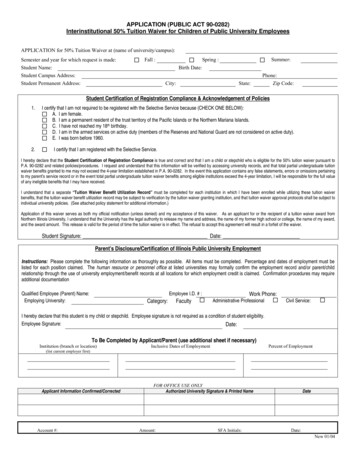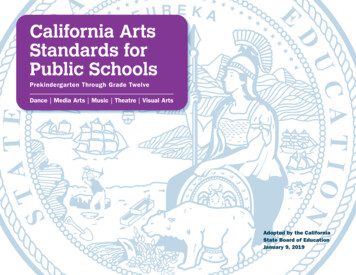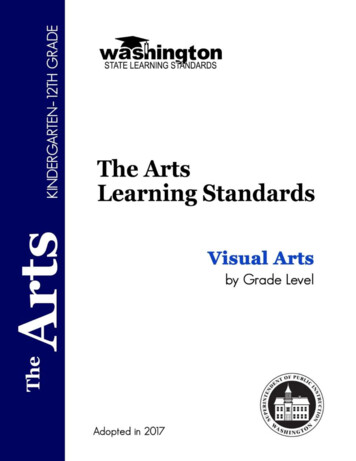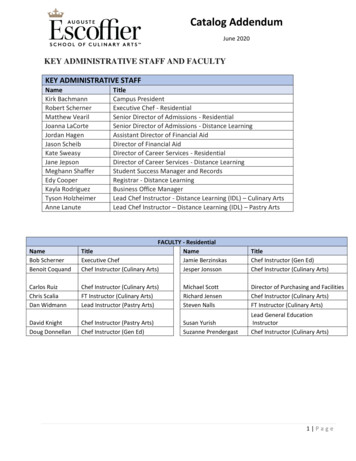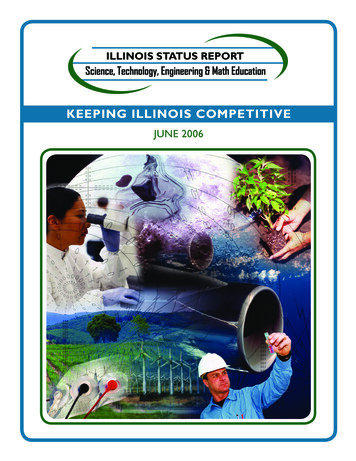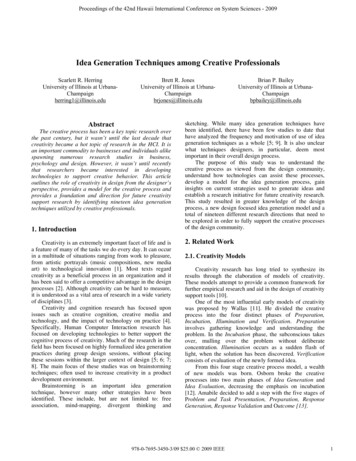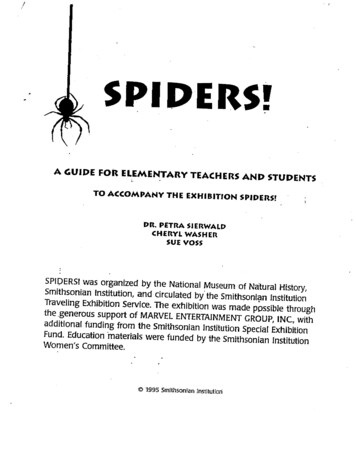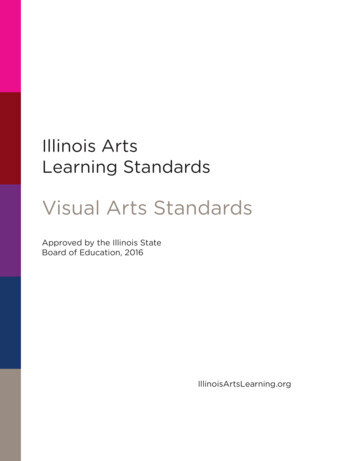
Transcription
Illinois ArtsLearning StandardsVisual Arts StandardsApproved by the Illinois StateBoard of Education, 2016IllinoisArtsLearning.org
Visual ArtsCREATINGAnchor Standard 1: Generate and conceptualize artistic ideas and work.Enduring Understanding: Creativity and innovative thinking are essential life skills that can be developed.Essential Questions: (a) What conditions, attitudes, and behaviors support creativity and innovative thinking? (b) What factorsprevent or encourage people to take creative risks? (c) How does collaboration expand the creative process?Investigate,Plan,MakePre VA:Cr1.1.23rdVA:Cr1.1.34thVA:Cr1.1.4a. Engage in selfdirected play withmaterials.a. Engage in explorationand imaginative playwith materials.a. Engagecollaboratively inexploration andimaginative play withmaterials.a. Brainstormcollaboratively multipleapproaches to an art ordesign problem.a. Elaborate on animaginative idea.a. Brainstorm multipleapproaches to a creativeart or design problem.Anchor Standard 1: Generate and conceptualize artistic ideas and work.Enduring Understanding: Artists and designers shape artistic investigations, following or breaking with traditions in pursuit of creative art-making goals.Essential Questions: (a) How does knowing the contexts, histories, and traditions of art forms help us create works of art and design? (b) Why do artists follow orbreak from established traditions? (c) How do artists determine what resources are needed to formulate artistic investigations?Investigate,Plan,MakePre VA:Cr1.2.23rdVA:Cr1.2.34thVA:Cr1.2.4a. Engage in selfdirected creative artmaking.a. Engagecollaboratively increative art making inresponse to an artisticproblem.a. Use observationand investigation inpreparation for makinga work of art.a. Make art or designwith various materialsand tools to explorepersonal interests,questions, and curiosity.a. Apply knowledge ofavailable resources,tools, and technologiesto investigate personalideas through the artmaking process.a. Collaboratively setgoals and create artworkthat is meaningful andhas purpose to themakers.2 Illinois Arts Learning Standards Visual ArtsApproved by the Illinois State Board of Education
.8Introductory HS LevelsVA:Cr1.1.IIntermediate HS Levels Advanced HS LevelsVA:Cr1.1.IIVA:Cr1.1.IIIa. Combine ideas togenerate an innovativeidea for art making.a. Combine conceptscollaboratively togenerate innovativeideas for creating art.a. Apply methods toovercome creativeblocks.a. Document earlystages of the creativeprocess visually orverbally in traditional ornew media.a. Use multipleapproaches to begincreative endeavors.a. Individually orcollaboratively formulatenew creative problemsbased on student’sexisting VA:Cr1.2.8Introductory HS LevelsVA:Cr1.2.IIntermediate HS Levels Advanced HS LevelsVA:Cr1.2.IIVA:Cr1.2.IIIa. Identify anddemonstrate diversemethods of artisticinvestigation to choosean approach forbeginning a work of art.a. Formulate anartistic investigationof personally relevantcontent for creating art.a. Develop criteria toguide making a work ofart or design to meet anidentified goal.a. Collaboratively shapean artistic investigationof an aspect ofpresent-day life using acontemporary practice ofart and design.a. Shape an artisticinvestigation of anaspect of presentday life using acontemporary practice ofart or design.a. Choose from arange of materials andmethods of traditionaland contemporaryartistic practices to planworks of art and design.Approved by the Illinois State Board of Educationa. Visualize andhypothesize to generateplans for ideas anddirections for creatingart and design that canaffect social change.a. Choose from arange of materialsand methods oftraditional andcontemporary artisticpractices, following orbreaking establishedconventions, to planthe making of multipleworks of art and designbased on a theme, idea,or concept.Illinois Arts Learning Standards Visual Arts 3
Visual ArtsCREATINGAnchor Standard 2: Organize and develop artistic ideas and work.Enduring Understanding: Artists and designers experiment with forms, structures, materials, concepts, media, and art-making approaches.Essential Questions: (a) How do artists work? (b) How do artists and designers determine whether a particular direction in their work is effective? (c) How doartists and designers learn from trial and error?InvestigatePre VA:Cr2.1.23rdVA:Cr2.1.34thVA:Cr2.1.4a. Use a variety of artmaking tools.a. Throughexperimentation, buildskills in various mediaand approaches to artmaking.a. Explore uses ofmaterials and tools tocreate works of art ordesign.a. Experiment withvarious materials andtools to explore personalinterests in a work of artor design.a. Create personallysatisfying artworkusing a variety ofartistic processes andmaterials.a. Explore and inventart-making techniquesand approaches.Anchor Standard 2: Organize and develop artistic ideas and work.Enduring Understanding: Artists and designers balance experimentation and safety, freedom, and responsibility while developing and creating artworks.Essential Questions: (a) How do artists and designers care for and maintain materials, tools, and equipment? (b) Why is it important for safety and health tounderstand and follow correct procedures in handling materials and tools? (c) What responsibilities come with the freedom to create?InvestigatePre VA:Cr2.2.23rdVA:Cr2.2.34thVA:Cr2.2.4a. Share materials withothers.a. Identify safe andnontoxic art materials,tools, and equipment.a. Demonstrate safe andproper procedures forusing materials, tools,and equipment whilemaking art.a. Demonstrate safeprocedures for usingand cleaning art tools,equipment, and studiospaces.a. Demonstrate anunderstanding of thesafe and proficientuse of materials, tools,and equipment fora variety of artisticprocesses.a. When making worksof art, utilize and carefor materials, tools, andequipment in a mannerthat prevents danger tooneself and others.Anchor Standard 2: Organize and develop artistic ideas and work.Enduring Understanding: People create and interact with objects, places, and design that define, shape, enhance, and empower their lives.Essential Questions: (a) How do objects, places, and design shape lives and communities? (b) How do artists and designers determine goals for designing orredesigning objects, places, or systems? (c) How do artists and designers create works of art or design that communicate effectively?InvestigatePre VA:Cr2.3.23rdVA:Cr2.3.34thVA:Cr2.3.4a. Create and tell aboutart that communicatesa story about a familiarplace or object.a. Create art thatrepresents naturaland constructedenvironments.a. Identify and classifyuses of everyday objectsthrough drawings,diagrams, sculptures, orother visual means.a. Repurpose objects tomake something new.a. Individually orcollaboratively constructrepresentations,diagrams, or maps ofplaces that are part ofeveryday life.a. Document, describe,and representregional constructedenvironments.4 Illinois Arts Learning Standards Visual ArtsApproved by the Illinois State Board of Education
.8Introductory HS LevelsVA:Cr2.1.IIntermediate HS Levels Advanced HS LevelsVA:Cr2.1.IIVA:Cr2.1.IIIa. Experiment anddevelop skills in multipleart-making techniquesand approaches throughpractice.a. Demonstrateopenness in tryingnew ideas, materials,methods, andapproaches in makingworks of art and design.a. Demonstratepersistence indeveloping skills withvarious materials,methods, andapproaches in creatingworks of art or design.a. Demonstratewillingness toexperiment, innovate,and take risks to pursueideas, forms, andmeanings that emergein the process of artmaking or designing.a. Engage in makinga work of art or designwithout having apreconceived plan.a. Throughexperimentation,practice, andpersistence,demonstrate acquisitionof skills and knowledgein a chosen art Cr2.2.8Introductory HS LevelsVA:Cr2.2.IIntermediate HS Levels Advanced HS LevelsVA:Cr2.2.IIVA:Cr2.2.IIIa. Demonstrate qualitycraftsmanship throughcare for and use ofmaterials, tools, andequipment.a. Explain environmentalimplications ofconservation, care, andcleanup of art materials,tools, and equipment.a. Demonstrateawareness of ethicalresponsibility to oneselfand others when postingand sharing imagesand other materialsthrough the Internet,social media, and othercommunication formats.a. Demonstrateawareness of practices,issues, and ethics ofappropriation, fair use,copyright, open source,and creative commonsas they apply to creatingworks of art and design.a. Explain howtraditional andnontraditionalmaterials may impacthuman health andthe environment anddemonstrate safehandling of materials,tools, and equipment.a. Demonstrateawareness of ethicalimplications of makingand distributing .78thVA:Cr2.3.8Introductory HS LevelsVA:Cr2.3.IIntermediate HS Levels Advanced HS LevelsVA:Cr2.3.IIVA:Cr2.3.IIIa. Identify, describe,and visually documentplaces or objects ofpersonal significance.a. Design or redesignobjects, places, orsystems that meetthe identified needs ofdiverse users.a. Apply visualorganizationalstrategies to design andproduce a work of art,design, or media thatclearly communicatesinformation or ideas.a. Select, organize, anddesign images andwords to make visuallyclear and compellingpresentations.a. Collaborativelydevelop a proposalfor an installation,artwork, or spacedesign that transformsthe perception andexperience of aparticular place.a. Redesign an object,system, place, ordesign in response tocontemporary issues.Approved by the Illinois State Board of Educationa. Experiment, plan, andmake multiple worksof art and design thatexplore a personallymeaningful theme, idea,or concept.a. Demonstrateunderstanding ofthe importance ofbalancing freedom andresponsibility in the useof images, materials,tools, and equipmentin the creation andcirculation of creativework.a. Demonstrate in worksof art or design howvisual and materialculture defines, shapes,enhances, inhibits, orempowers people’s lives.Illinois Arts Learning Standards Visual Arts 5
Visual ArtsCREATINGAnchor Standard 3: Revise, refine, and complete artistic work.Enduring Understanding: Artists and designers develop excellence through practice and constructive critique, reflecting on, revising, and refining work over time.Essential Questions: (a) What role does persistence play in revising, refining, and developing work? (b) How do artists grow and become accomplished in artforms? (c) How does collaboratively reflecting on a work help us experience it more completely?Reflect,Refine,ContinuePre VA:Cr3.1.23rdVA:Cr3.1.34thVA:Cr3.1.4a. Share and talk aboutpersonal artwork.a. Explain the processof making art whilecreating.a. Use art vocabulary todescribe choices whilecreating art.a. Discuss and reflectwith peers about choicesmade in creatingartwork.a. Elaborate visualinformation by addingdetails in an artworkto enhance emergingmeaning.a. Revise artwork inprogress on the basis ofinsights gained throughpeer discussion.PRESENTINGAnchor Standard 4: Select, analyze, and interpret artistic work for presentation.Enduring Understanding: Artists and other presenters consider various techniques, methods, venues, and criteria when analyzing, selecting, and curatingobjects, artifacts, and artworks for preservation and presentation. Essential Questions: (a) How are artworks cared for and by whom? (b) What criteria, methods,and processes are used to select work for preservation or presentation? (c) Why do people value objects, artifacts, and artworks and select them for presentation?RelatePre VA:Pr4.1.23rdVA:Pr4.1.34thVA:Pr4.1.4a. Identify reasons forsaving and displayingobjects, artifacts, andartwork.a. Select art objects fora personal portfolio anddisplay, explaining whythey were chosen.a. Explain why someobjects, artifacts, andartworks are valued overothers.a. Categorize artworkbased on a theme orconcept for an exhibit.a. Investigate anddiscuss possibilities andlimitations of spaces,including electronic, forexhibiting artwork.a. Compare and contrasthow technologieshave changed the wayartwork is preserved,presented, andexperienced.Anchor Standard 5: Develop and refine artistic techniques and work for presentation.Enduring Understanding: Artists, curators, and others consider a variety of factors and methods, including evolving technologies, when preparing and refiningartwork for display or when deciding if and how to preserve and protect artwork. Essential Questions: (a) What methods and processes are considered whenpreparing artwork for presentation or preservation? (b) How does refining artwork affect its meaning to the viewer? (c) What criteria are considered whenselecting work for presentation, a portfolio, or a collection?SelectPre KVA:Pr4.1.PKKindergartenVA:Pr4.1.Ka. Identify places whereart may be displayed orsaved.a. Explain the purpose of a. Ask and answera portfolio or collection. questions such aswhere, when, why,and how artworkshould be preparedfor presentation orpreservation.6 Illinois Arts Learning Standards Visual r4.1.4a. Distinguish betweendifferent materials orartistic techniques forpreparing artwork forpresentation.a. Identify exhibitspace and prepareworks of art, includingartists’ statements, forpresentation.a. Analyze the variousconsiderations forpresenting andprotecting art in variouslocations, indoor oroutdoor settings, intemporary or permanentforms, and in physical ordigital formats.Approved by the Illinois State Board of Education
.8Introductory HS LevelsVA:Cr3.1.IIntermediate HS Levels Advanced HS LevelsVA:Cr3.1.IIVA:Cr3.1.IIIa. Create artiststatements using artvocabulary to describepersonal choices madein art making.a. Reflect on whetherpersonal artworkconveys the intendedmeaning and reviseaccordingly.a. Reflect on and explainimportant informationabout personal artworkin an artist statement oranother format.a. Apply relevant criteriato examine, reflect on,and plan revisions for awork of art or design inprogress.a. Apply relevant criteriafrom traditional andcontemporary culturalcontexts to examine,reflect on, and planrevisions for works of artand design in progress.a. Engage inconstructive critiquewith peers, then reflecton, reengage, revise,and refine works of artand design in responseto personal .1.78thVA:Pr4.1.8Introductory HS LevelsVA:Pr4.1.IIntermediate HS Levels Advanced HS LevelsVA:Pr4.1.IIVA:Pr4.1.IIIa. Define the roles andresponsibilities of acurator, explaining theskills and knowledgeneeded in preserving,maintaining, andpresenting objects,artifacts and artwork.a. Analyze similaritiesand differencesassociated withpreserving andpresenting twodimensional, threedimensional, and digitalartwork.a. Analyze howpast, present, andemerging technologieshave impacted thepreservation andpresentation of artwork.a. Develop and applycriteria for evaluating acollection of artwork forpresentation.a. Analyze, select,and curate artifactsor artworks forpresentation andpreservation.a. Analyze, select,and critique personalartwork for a collectionor portfolio .78thVA:Pr4.1.8Introductory HS LevelsVA:Pr4.1.IIntermediate HS Levels Advanced HS LevelsVA:Pr4.1.IIVA:Pr4.1.IIIa. Develop a logicalargument for safeand effective useof materials andtechniques for preparingand presenting artwork.a. Individually orcollaboratively, developa visual plan fordisplaying works of art,analyzing exhibit space,the needs of the viewer,and the layout of theexhibit.a. Based on criteria,analyze and evaluatemethods for preparingand presenting art.a. Collaborativelya. Analyze and evaluateprepare and presentthe reasons and ways anselected theme-basedexhibition is presented.artwork for display andformulate exhibitionnarratives for the viewer.Approved by the Illinois State Board of Educationa. Evaluate, select,and apply methods orprocesses appropriateto display artwork in aspecific place.a. Reflect on, reengage,revise, and refineworks of art or designconsidering relevanttraditional andcontemporary criteria aswell as personal artisticvision.a. Critique, justify, andpresent choices in theprocess of analyzing,selecting, curating, andpresenting artwork for aspecific exhibit or event.a. Investigate, compare,and contrast methodsfor preserving andprotecting art.Illinois Arts Learning Standards Visual Arts 7
Visual ArtsPRESENTINGAnchor Standard 6: Convey meaning through the presentation of artistic work.Enduring Understanding: Objects, artifacts, and artworks collected, preserved, or presented by artists, museums, or other venues communicate meaning and arecord of social, cultural, and political experiences resulting in the cultivation of appreciation and understanding.Essential Questions: (a) What is an art museum? (b) How does the presenting and sharing of objects, artifacts, and artworks influence and shape ideas, beliefs,and experiences? (c) How do objects, artifacts, and artworks collected, preserved, or presented cultivate appreciation and understanding?AnalyzePre VA:Pr6.1.23rdVA:Pr6.1.34thVA:Pr6.1.4a. Identify where art isdisplayed both insideand outside of school.a. Explain what anart museum is anddistinguish how an artmuseum is differentfrom other buildings.a. Identify the rolesand responsibilities ofpeople who work in andvisit museums and otherart venues.a. Analyze how artexhibited inside andoutside of schools (forexample, in museums,galleries, virtualspaces, and othervenues) contributes tocommunities.a. Identify and explainhow and where differentcultures record andillustrate stories andhistory of life throughart.a. Compare andcontrast purposes of artmuseums, art galleries,and other venues, aswell as the types ofpersonal experiencesthey provide.RESPONDINGAnchor Standard 7: Perceive and analyze artistic work.Enduring Understanding: Individual aesthetic and empathic awareness developed through engagement with art can lead to understanding and appreciation ofself, others, the natural world, and constructed environments. Essential Questions: (a) How do life experiences influence the way you relate to art? (b) How doeslearning about art impact how we perceive the world? (c) What can we learn from our responses to art?SharePre VA:Re7.1.23rdVA:Re7.1.3a. Recognize art in one’senvironment.a. Identify uses ofart within one’senvironment.a. Select and describeworks of art thatillustrate daily lifeexperiences of self andothers.a. Perceive and describe a. Speculate aboutaesthetic characteristics processes an artist usesof one’s natural worldto create a work of art.and constructedenvironments.4thVA:Re7.1.4a. Compare responses toa work of art before andafter working in similarmedia.Anchor Standard 7: Perceive and analyze artistic work.Enduring Understanding: Visual imagery influences understanding of, and responses to, the world.Essential Questions: (a) What is an image? (b) Where and how do we encounter images in our world? (c) How do images influence our views of the world?PerceivePre VA:Re7.2.23rdVA:Re7.2.34thVA:Re7.2.4a. Distinguish betweenimages and real objects.a. Describe what animage represents.a. Compare imagesthat represent the samesubject.a. Categorize imagesbased on expressiveproperties.a. Determine messagescommunicated by animage.a. Analyze componentsin visual imagery thatconvey messages.8 Illinois Arts Learning Standards Visual ArtsApproved by the Illinois State Board of Education
.8Introductory HS LevelsVA:Pr6.1.IIntermediate HS Levels Advanced HS LevelsVA:Pr6.1.IIVA:Pr6.1.IIIa. Cite evidence abouthow an exhibition in amuseum or other venuepresents ideas andprovides informationabout a specific conceptor topic.a. Assess, explain,and provide evidenceof how museums orother venues reflecthistory and values of acommunity.a. Compare andcontrast viewing andexperiencing collectionsand exhibitions indifferent venues.a. Analyze why andhow an exhibition orcollection may influenceideas, beliefs, andexperiences.a. Analyze anddescribe the impactthat an exhibitionor collection has onpersonal awarenessof social, cultural, orpolitical beliefs andunderstandings.a. Make, explain, andjustify connectionsbetween artists orartwork and social,cultural, and e7.1.78thVA:Re7.1.8Introductory HS LevelsVA:Re7.1.IIntermediate HS Levels Advanced HS LevelsVA:Re7.1.IIVA:Re7.1.IIIa. Compare one’s owninterpretation of awork of art with theinterpretation of others.a. Identify and interpretworks of art or designthat reveal how peoplelive around the worldand what they value.a. Explain how themethod of display,the location, and theexperience of an artworkinfluence how it isperceived and valued.a. Explain how aperson’s aestheticchoices are influencedby culture andenvironment and impactthe visual image thatone conveys to others.a. Hypothesize ways inwhich art influencesperception andunderstanding of humanexperiences.a. Recognize anddescribe personalaesthetic andempathetic responsesto the natural worldand 7thVA:Re7.2.78thVA:Re7.2.8Introductory HS LevelsVA:Re7.2.IIntermediate HS Levels Advanced HS LevelsVA:Re7.2.IIVA:Re7.2.IIIa. Identify and analyzecultural associationssuggested by visualimagery.a. Analyze ways thatvisual components andcultural associationssuggested by imagesinfluence ideas,emotions, and actions.a. Analyze multiple waysthat images influencespecific audiences.a. Compare and contrastcontexts and media inwhich viewers encounterimages that influenceideas, emotions, andactions.a. Analyze how one’sunderstanding of theworld is affected byexperiencing visualimagery.a. Evaluate theeffectiveness of animage or imagesto influence ideas,feelings, and behaviorsof specific audiences.Approved by the Illinois State Board of Educationa. Curate a collectionof objects, artifacts, orartwork to impact theviewer’s understandingof social, cultural orpolitical experiences.a. Analyze howresponses to art developover time based onknowledge of, andexperience with, artand life.a. Determine thecommonalities within agroup of artists or visualimages attributed to aparticular type of art,timeframe, or culture.Illinois Arts Learning Standards Visual Arts 9
Visual ArtsRESPONDINGAnchor Standard 8: Construct meaningful interpretations of artistic work.Enduring Understanding: People gain insights into meanings of artworks by engaging in the process of art criticism.Essential Questions: (a) What is the value of engaging in the process of art criticism? (b) How can the viewer “read” a work of art as text? (c) How does knowingand using visual art vocabularies help us understand and interpret works of art?PerceivePre VA:Re8.1.23rdVA:Re8.1.34thVA:Re8.1.4a. List details in worksof art.a. List details andidentify subject matterof works of art.a. Identify subjectmatter and describecharacteristics of worksof art.a. Communicatefeelings when engagingworks of art, anddescribe subject matterand characteristics.a. Communicatefeelings when engagingworks of art, anddescribe subjectmatter and formalcharacteristics todiscuss meanings ofartwork.a. Communicatefeelings when engagingworks of art anddescribe subject matter,formal characteristics,and art-makingapproaches to discussmeanings of artwork.Anchor Standard 9: Apply criteria to evaluate artistic work.Enduring Understanding: People evaluate art based on various criteria. Essential Questions: (a) How does one determine criteria to evaluate a work of art?(b) How and why might criteria vary? (c) How is a personal preference different from an evaluation?AnalyzePre VA:Re9.2.23rdVA:Re9.2.34thVA:Re9.2.4a. Select a preferredartwork.a. Explain reasons forselecting a preferredartwork.a. Classify artworkbased on differentreasons for preferences.a. Use learned artvocabulary to expresspreferences aboutartwork.a. Evaluate an artworkbased on given criteria.a. Apply one set ofcriteria to evaluate morethan one work of art.CONNECTINGAnchor Standard 10: Synthesize and relate knowledge and personal experiences to make art.Enduring Understanding: Through art making, people make meaning by investigating and developing awareness of perceptions, knowledge, and experiences.Essential Questions: (a) How does engaging in creating art enrich people’s lives? (b) How does making art attune people to their surroundings? (c) How do peoplecontribute to awareness and understanding of their lives and the lives of their communities through art making?InterpretPre KVA:Cn10.1.PKKindergartenVA:Cn10.1.Ka. Explore the worlda. Create art that tellsusing descriptive anda story about a lifeexpressive words and art experience.making.10 Illinois Arts Learning Standards Visual A:Cn10 .1.4a. Identify times, places,and reasons by whichstudents make artoutside of school.a. Create works of artabout events in home,school, or communitylife.a. Develop a work of artbased on observationsof surroundings.a. Create works of artthat reflect communityor cultural traditions.Approved by the Illinois State Board of Education
.8Introductory HS LevelsVA:Re8.1.IIntermediate HS Levels Advanced HS LevelsVA:Re8.1.IIVA:Re8.1.IIIa. Interpret art throughdescribing andanalyzing feelings,subject matter, formalcharacteristics, artmaking approaches, andcontextual information.a. Collaborativelyinterpret art andgenerate meaningsthrough describingand analyzing feelings,subject matter, formalcharacteristics, artmaking approaches, andcontextual information.a. Interpret art andgenerate meaningsthrough describingand analyzing feelings,subject matter, formalcharacteristics, artmaking approaches, andcontextual informationand identify keyconcepts.a. Collaborativelydevelop meaningfulinterpretations,supported by evidence,of artworks throughdescribing andanalyzing feelings,subject matter, formalcharacteristics, artmaking approaches,contextual information,and key concepts.a. Construct meaningfulinterpretations,supported by evidence,of an artwork orcollection of worksthrough describingand analyzing feelings,subject matter, formalcharacteristics, artmaking approaches,contextual information,and key concepts.a. Construct andsupport meaningfulinterpretations,supported by evidence,of an artwork orcollection of worksthrough describingand analyzing feelings,subject matter, formalcharacteristics, artmaking approaches,contextual information,and key hVA:Re9.2.8Introductory HS LevelsVA:Re9.2.IIntermediate HS Levels Advanced HS LevelsVA:Re9.2.IIVA:Re9.2.IIIa. Recognize differencesin criteria used toevaluate works of artdepending on styles,genres, and media aswell as historical andcultural contexts.a. Develop and applyrelevant criteria toevaluate a work of art.a. Compare andexplain the differencebetween an evaluationof an artwork based onpersonal criteria and anevaluation of an artworkbased on a set ofestablished criteria.a. Create a convincingand logical argument tosupport an evaluationof art.a. Establish relevantcriteria in order toevaluate a work of art orcollection of works.a. Determine therelevance of criteriaused by others toevaluate a work of art orcollection of hVA:Cn10.1.8Introductory HS LevelsVA:Cn10.1.IIntermediate HS Levels Advanced HS LevelsVA:Cn10.1.IIVA:Cn10.1.IIIa. Apply formal andconceptual vocabulariesof art and design toview surroundings innew ways through artmaking.a. Generate a collectionof ideas reflectingcurrent interests andconcerns that couldbe investigated in artmaking.a. Individually orcollaboratively createvisual documentationof places and times inwhich people gather tomake and experienceart or design in thecommunity.a. Make artcollaboratively to reflecton and reinforce positiveaspects of groupidentity.a. Document the processof developing ideas fromearly stages to fullyelaborated ideas.a. Utilize inquirymethods of observation,research, andexperimentation toexplore unfamiliarsubjects through artmaking.Approved by the Illinois State Board of Educationa. Compare andcontrast differinginterpretations of anartwork or collection ofworks and explain howvarious interpretationsenrich experiences of artand life.a. Construct evaluationsof a work of art orcollection of worksbased on differing setsof criteria.a. Synthesize knowledgeof social, cultural,historical, and personallife with art-makingapproaches to createmeaningful works of artor design.Illinois Arts Learning Standards Visual Arts 11
Visual ArtsCONNECTINGAnchor Standard 11: Relate artistic ideas and works with societal, cultural, and historical context to deepen understanding.Enduring Understanding: People develop ideas and understandings of society, culture, and history through their interactions with and analysis of art.Essential Questions: (a) How does art help us understand the lives of people in different times, places, and cultures? (b) How is art used to impact the viewsof a society? (c) How does art preserve aspects of life?SynthesizePre KVA:Cn11.1.PKKindergartenVA:Cn11.1.K1stVA:Cn11.1.1
2 Illinois Arts Learning Standards Visual Arts Arove te Illinois tate oar o ation CREATING Anchor Standard 1: Generate and conceptualize artistic ideas and work. Enduring Understanding: Creativity and innovative thinking are essential life skills that can be developed. Essential Questions: (a) What conditions, attitudes, and behaviors support creativity and innovative thinking?

